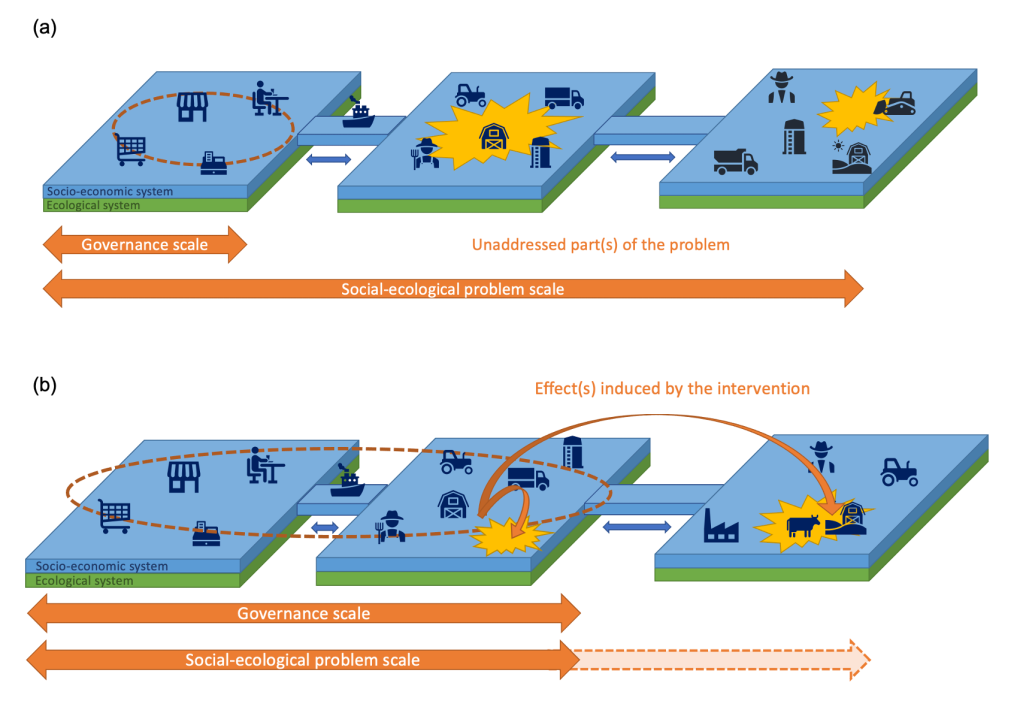By Johanna Coenen, Gabi Sonderegger, Jens Newig, Patrick Meyfroidt, Edward Challies, Simon L. Bager, Louise M. Busck-Lumholt, Esteve Corbera, Cecilie Friis, Anna Frohn Pedersen, Perrine C.S.J. Laroche, Claudia Parra Paitan, Siyu Qin, Nicolas Roux, Julie G. Zaehringer
In today’s interconnected world, local sustainability issues such as deforestation, biodiversity loss, agri-chemical pollution and food insecurity are increasingly shaped by global commodity flows and the actions of distant actors. The demand for commodities such as soy, palm oil, cocoa, rubber and meat can have adverse social and environmental consequences in the production regions that are often geographically distant from the consumption sites. Such sustainability challenges often transcend traditional political boundaries, posing difficulties in designing governance institutions that adequately fit their scale. Where governance institutions fail to align with the scale of the problems they are meant to address, we encounter issues referred to as “problems of fit”, “mismatches”, or “misfits”. The governance of global commodity flows is particularly beset with such problems of fit.
In our recent article, published in Ecology and Society, we explore the spatial dimension of governance fit concerning global commodity flows. In doing so, we synthesize some key findings of the COUPLED project. We shed light on two key types of governance mismatches: boundary and resolution mismatches (Table 1).
Table 1. Boundary and resolution mismatches in the governance of telecoupled social-ecological systems.
| Boundary mismatch | Resolution mismatch | ||
| Definition | Governance institutions neglect social-ecological problems that transcend established administrative or jurisdictional boundaries | Governance institutions have too coarse a spatial resolution than is suitable to address the social-ecological problems at hand | |
| Underlying problem | Lack of governance extent | Lack of governance precision | |
| Mechanism | Spillover | Leakage | Panacea trap |
| Description | Governance institutions do not govern a social-ecological problem that expands beyond their administrative or jurisdictional boundaries | Governance institutions address a social-ecological problem but create leakage(s), i.e., counterproductive effects outside the targeted area or domain of the intervention | Governance institutions are not specific enough to be effectively implemented and enforced |
We present empirical examples of the different types of mismatches from both public and private governance perspectives in this publication. We also graphically illustrate the different mismatches. For example, Figure 1 displays boundary mismatches.
Figure 1. Boundary mismatches. Governance institutions neglect social-ecological problems that transcend established jurisdictional boundaries due to spillovers (A) or leakages (B).

Furthermore, we examine three approaches to address mismatches, namely due diligence laws and policies, landscape and jurisdictional approaches to supply chain governance, and environmental provisions in trade agreements. We show that any attempt to resolve boundary or resolution mismatches comes with the risk of creating new mismatches. We find that no single governance approach can address all mismatches, emphasizing the need for the alignment of multiple governance approaches to effectively govern global commodity flows.
Read the publication
